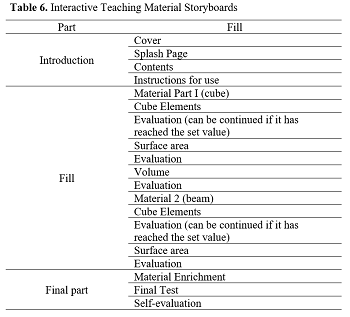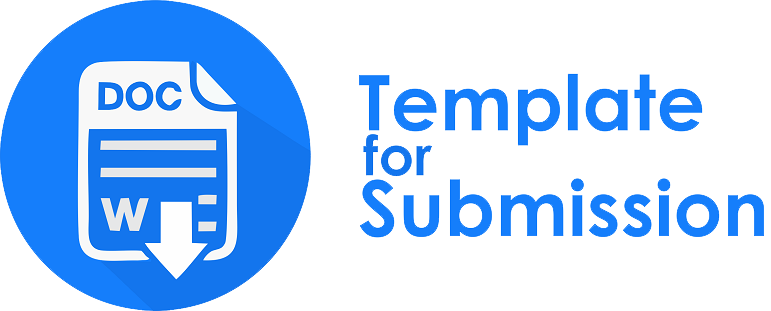DEVELOPMENT OF INTERACTIVE TEACHING MATERIALS WITH RME-BASED ISPRING SUITE TO IMPROVE STUDENTS' CREATIVE THINKING SKILLS
Abstract
With the use of the RME-based iSpring suite, this project creates interactive teaching resources to enhance students' capacity for creative thought. Students' low capacity for creative thought, low levels of desire, low levels of activity, and low levels of involvement in the learning process are the field's problems. In order to address these issues, interactive instructional resources were created. With the help of RME-based ispring suites, interactive teaching materials will be created that are valid, useful in the educational process, and will enhance students' capacity for creative thought. 4D (define, design, development, disseminate) is the development model that is employed. Pretest-poste instruments, student response questionnaires, and validation sheets are used in data gathering procedures. Analysis methods include the paired sample t-test, validity test, and practicality test, n-gain test. With a score of 3.41, the validity test results indicate that the product is already in the legitimate category. According to the analysis of the practicality test results, the produced product already has a score of 3.43, placing it in the extremely practical category. It is established by the paired sample t-test that capacity differences exist between pre- and post-use of interactive training resources. Moreover, improving pupils' capacity for creative thought is known to fall into the effective group based on the results of the n-gain test. In order for the RME-based iSpring suite of interactive teaching resources to be generally appropriate for use in the learning process
Downloads
References
Amami Pramuditya, S., Noto, M. S., & Syaefullah, D. (2017). Game Edukasi Rpg Matematika. Eduma : Mathematics Education Learning and Teaching, 6(1), 77. https://doi.org/10.24235/eduma.v6i1.1701
Azaryahu, L., Broza, O., Cohen, S., Hershkovitz, S., & Adi-Japha, E. (2023). Development of creative thinking patterns via math and music. Thinking Skills and Creativity, 47, 101196. https://doi.org/10.1016/J.TSC.2022.101196
Cahyanti, A. D., Farida, F., & Rakhmawati, R. (2019). Pengembangan Alat Evaluasi Berupa Tes Online/Offline Matematika dengan Ispring Suite 8. Indonesian Journal of Science and Mathematics Education, 2(3), 363–371. https://doi.org/10.24042/ijsme.v2i3.4362
Hewi, L., & Shaleh, M. (2020). Refleksi Hasil PISA (The Programme For International Student Assesment): Upaya Perbaikan Bertumpu Pada Pendidikan Anak Usia Dini). Jurnal Golden Age, 4(01), 30–41. https://doi.org/10.29408/jga.v4i01.2018
Iskandar, S. F. R., & Raditya, A. (2017). Pengembangan Bahan Ajar Project-Based Learning Berbantuan Scratch. Seminar Nasional Matematika Dan Aplikasinya, 2013, 167.
Jupri, A. (2015). Dengan Pendekatan Matematika Realistik. Prosiding Seminar Nasional Matematika Dan Pendidikan Matematika, 303–314.
K.A. Nalasari, N.K. Suarni, & I.M.C. Wibawa. (2021). Pengembangan Bahan Ajar Berbasis Web Google Sites Pada Tema 9 Subtema Pemanfaatan Kekayaan Alam Di Indonesia Untuk Siswa Kelas Iv Sekolah Dasar. Jurnal Teknologi Pembelajaran Indonesia, 11(2), 135–146. https://doi.org/10.23887/jurnal_tp.v11i2.658
Kartikasari, I. A., Usodo, B., & Riyadi. (2022). The Effectiveness Open-Ended learning and Creative Problem Solving Models to Teach Creative Thinking Skills. Pegem Egitim ve Ogretim Dergisi, 12(4), 29–38. https://doi.org/10.47750/pegegog.12.04.04
Martiningsih, R. R. (2018). Peningkatan Hasil Belajar Himpunan Dengan Menggunakan Aplikasi Ispring Suite 8. Jurnal Teknodik, 35. https://doi.org/10.32550/teknodik.v21i3.344
Misselya, N. G. (2023). Pengembangan Media Pembelajaran Kartu Maya (Macam-Macam Gaya) Berbasis E-Card Interaktif Untuk Meningkatkan Hasil Belajar IPA di Sekolah Dasar. Jpgsd, 11(2), 403–413.
Palguna, I., Parwati, N. N., & Divayana, D. (2020). Pengaruh model pembelajaran Auditory, Intellectually, Repetition berbantuan media pembelajaran I-Spring terhadap motivasi dan kemampuan pemecahan masalah matematika siswa SMA. Jurnal Teknologi Pembelajaran Indonesia, 10(2), 56–75.
PISA. (2023). PISA 2022 Results Factsheets Indonesia. The Language of Science Education, 1, 1–9. https://oecdch.art/a40de1dbaf/C108.
Pranata, D. pidi, Frima, A., & Egok, A. sukenda. (2021). Pengembangan LKS Matematika Berbasis Problem Based Learning pada Materi Bangun Datar Sekolah Dasar. 5(4), 2284–2301.
Putrawangsa, S., & Hasanah, U. (2018). Integrasi Teknologi Digital Dalam Pembelajaran Di Era Industri 4.0. Jurnal Tatsqif, 16(1), 42–54. https://doi.org/10.20414/jtq.v16i1.203
Rahma, M., Yulis, E., Pratiwi, N., Susanto, R., & Syofyan, H. (2021). Pemanfaatan Teknologi Informasi dan Komunikasi untuk Mengembangkan Kompetensi Pedagogik Guru. Eduscience: Jurnal Ilmu Pendidikan, 6(2), 97–105. https://digilib.esaunggul.ac.id/public/UEU-Journal-19913-11_1192.pdf
Rohaeti, E. E., Bernard, M., & Novtiar, C. (2019). Pengembangan Media Visual Basic Application untuk Meningkatkan Kemampuan Penalaran Siswa SMP dengan Pendekatan Open-Ended. Supremum Journal of Mathematics Education, 3(2), 95–108.
Sari, I. P., Nurtamam, M. E., & Hanik, U. (2020). Pengembangan Multimedia Interaktif Berbasis Game 2D Flash Pada Pembelajaran Matematika Materi Pecahan Sederhana Untuk Siswa Kelas III UPTD SDN Banyuajuh 4 Kamal. Widyagogik : Jurnal Pendidikan Dan Pembelajaran Sekolah Dasar, 7(2), 83–91. https://doi.org/10.21107/widyagogik.v7i2.7815
Sari, P. (2019). Analisis Terhadap Kerucut Pengalaman Edgar Dale Dan Keragaman Dalam Memilih Media. Jurnal Manajemen Pendidikan, 1(1), 42–57.
Septianingrum, R. A., Wahyuningsih, E. D., & Utami, W. B. (2019). Model Pembelajaran Two-Stay Two-Stray Berbantuangeogebra Terhadap Kemampuan Koneksi Matematis. Jurnal Edukasi Dan Sains Matematika (JES-MAT), 5(2), 113. https://doi.org/10.25134/jes-mat.v5i2.1860
Sugiyono. (2019). Metode Penelitian Pendidikan (Kuantitatif, Kualitatif, Kombinasi, R&D dan Penelitian Pendidikan) (Alfabeta).
Suherman, S., & Vidákovich, T. (2022). Assessment of mathematical creative thinking: A systematic review. Thinking Skills and Creativity, 44(January). https://doi.org/10.1016/j.tsc.2022.101019
Sumilat, J. M. (2018). Pemanfaatan Media Pembelajaran Matematika Interaktif Untuk Meningkatkan Hasil Belajar Siswa Di Sd Negeri 2 Tataaran. Inventa, 2(1), 40–46. https://doi.org/10.36456/inventa.2.1.a1624
Supianti, I. I. (2018). Pemanfataan Teknologi Informasi dan Komunikasi (TIK) dalam Pembelajaran Matematika. MENDIDIK: Jurnal Kajian Pendidikan Dan Pengajaran, 4(1), 63–70. https://doi.org/10.30653/003.201841.44
Watson, A., & Geest, E. (2005). Principled Teaching for Deep Progress. Educational Studies in Mathematics, 58(2), 209–234.
Yulianty, N. (2019). Kemampuan Pemahaman Konsep Matematika Siswa Dengan Pendekatan Pembelajaran Matematika Realistik. Jurnal Pendidikan Matematika Raflesia, 4(1), 60–65. https://doi.org/10.33449/jpmr.v4i1.7530

Copyright (c) 2024 Barra P Pradja, Nisvu Nanda Saputra, Abdul Baist, Retno Andriyani, Hairul Saleh, Ratu Sarah Fauziah Iskandar

This work is licensed under a Creative Commons Attribution-NonCommercial-ShareAlike 4.0 International License.
License and Copyright Agreement
By submitting a manuscript to Jurnal Pendidikan Matematika (JUPITEK), the author(s) certify and agree to the following terms:
- Originality and Authority: The submitting author is authorized by all co-authors to enter into this agreement. The manuscript describes original work that has not been published previously in a peer-reviewed journal, nor is it under consideration for publication elsewhere.
- Approval: Its publication has been approved by all author(s) and by the responsible authorities of the institutions where the work was carried out.
- Rights: The authors secure the right to reproduce any material that has already been published or copyrighted elsewhere.
- Licensing and Copyright: Authors retain the copyright to their work.
- License Grant: The authors grant Jurnal Pendidikan Matematika (JUPITEK) the right of first publication, with the work simultaneously licensed under the Creative Commons Attribution-NonCommercial-ShareAlike 4.0 International (CC BY-NC-SA 4.0).
- Self-Archiving: Authors are permitted and encouraged to deposit the published version of their article in institutional repositories, on their personal websites, and other academic platforms, with proper acknowledgment of its initial publication in Jurnal Pendidikan Matematika (JUPITEK).





.png)


